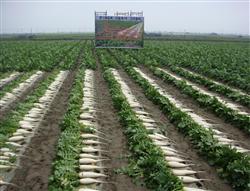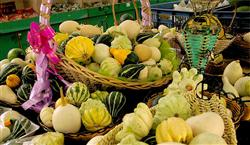Control methods of main diseases of radish

First, radish downy mildew is mainly caused by leaves, and stems, flowers and pods can also be damaged. The diseased leaves produce water-immersed chlorotic spots at the initial stage, and later develop into polygonal or irregular yellowish-brown spots. When the humidity is high, a white mildew layer grows on the back of the leaf. When the disease is serious, the disease spots are continuous, causing the leaves to turn yellow and dry. Germs like warm and high humidity conditions. Especially in autumn, it is rainy, humid, the temperature difference between day and night is big, foggy again, and the disease is easy to spread. In the process of cultivation, the disease is more serious in continuous cropping, low-lying land, excessive planting density, weak growth and so on. Prevention and treatment methods: 800 times solution of 25% metalaxyl wettable powder, 400 times solution of 64% alum wettable powder, or 600 times liquid of 58% metalaxyl wettable powder, once every 7 days, continuous prevention and treatment for 3 times. Second, radish black rot pathogen is mostly harmful to leaves, causing leaf edge disease, showing "? At the end of the fraud "fold 8? Is injured, part of the outer skin becomes black, or does not change color, the internal dry rot, vascular bundles blacken, the pulp is black dry rot, or even hollow. In general, the disease is serious in the fields with high temperature, early sowing, extensive management and untimely pest control. Control methods: (1) seed disinfection: soak the seeds in 50 ℃ warm water for 20 minutes, or soak the seeds with 72% agricultural streptomycin sulfate soluble powder 3000 times solution for 2 hours. (2) Pharmaceutical control: 72% agricultural streptomycin sulfate wettable powder 4000 times solution or 77% agricultural streptomycin sulfate wettable powder solution was used at the initial stage of the disease, once every 7 days for 3 consecutive times. Third, radish soft rot is mainly harmful to fleshy roots and petioles. First, the disease occurs from the position where the root is in contact with the ground, and the disease shows a soft rot in the form of water, which is gently pulled out by hand and disconnected from the site of the disease. Bacteria like high temperature and high humidity. Rain Water too much, over-irrigation, easy to get sick. Prevention and control methods: (1) rational use of water, avoid flood irrigation, timely drainage after rain. (2) remove the diseased plant in time and disinfect the root point with lime. (3) thoroughly remove the diseased and residual plants after harvest and kill the bacteria deeply. (3) timely use of drugs in the early stage of the disease. 72% agricultural streptomycin soluble powder 400 times solution, or 50% chemical ammonium water agent 800 times solution, or 70% dioxone wettable powder 800 times solution for prevention and control. Fourth, the black spot of radish is mainly harmful to leaves. The disease spot is round, nearly round or irregular, light brown to brown, and the leaves turn yellow when the disease is serious. The incidence increased when the temperature was high and it was rainy and humid. Prevention and treatment: at the initial stage of the disease, use 75% chlorothalonil wettable powder 600x liquid, or 50% prohydantoin wettable powder 1000 times liquid spray. Once every 7 days, 2 consecutive murmurs for 3 times.
- Prev

Cultivation techniques of Mini Carrot
1. Variety sources finger-shaped carrots and spherical carrots are new varieties of carrots introduced from Nagoya, Japan in 2003 by the vegetable Institute of Inner Mongolia Academy of Agriculture and Animal Husbandry Sciences. Trial planting are all pocket mini carrots, which can be used as specialties, raw food and dish platter decoration. Second, characteristics 1. Refers to.
- Next

Cultivation techniques of ornamental Pumpkin
Variety selection ornamental pumpkin series varieties are flying saucer, zebra, microphone, flower face, golden egg, silver egg, Wuzhishan, golden boy, jade girl, incense burner, white jade, golden apple, small wall clock, a little green, a little yellow, small pillow, small gourd and so on. Growers had better buy mixed seeds for mixed planting.
Related
- Where is it suitable to grow horseradish in China? it is expected to see the middle altitude horseradish in Alishan.
- How to prevent tomato virus disease reasonably? (Control methods included)
- Many people like to plant towel gourd on the balcony. What are the main points of this method and management?
- What crops can chili peppers be mixed with?
- Fertilization techniques and matters needing attention in Tomato
- What are the grafting techniques for peach seedlings in spring?
- Harm and control methods of root swelling disease of Chinese cabbage
- What are the pests of sweet potatoes? How to prevent and cure it?
- Symptoms, causes and Control methods of navel Rot in Tomato
- The cause of "Cucumber rotten bibcock" in Farmers' planting Cucumber and its Control Plan

